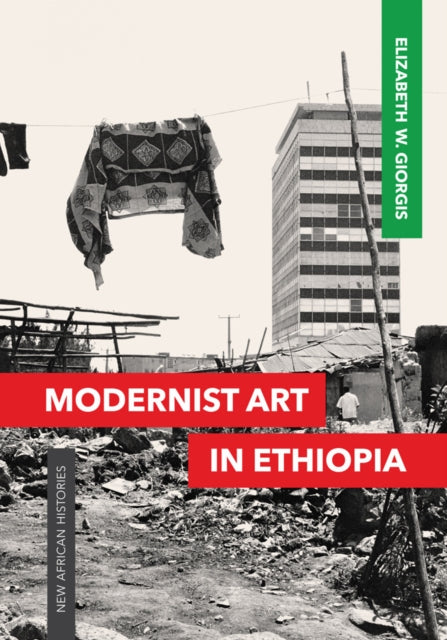Elizabeth W. Giorgis
Modernist Art in Ethiopia
Modernist Art in Ethiopia
YOU SAVE £5.18
- Condition: Brand new
- UK Delivery times: Usually arrives within 2 - 3 working days
- UK Shipping: Fee starts at £2.39. Subject to product weight & dimension
Bulk ordering. Want 15 or more copies? Get a personalised quote and bigger discounts. Learn more about bulk orders.
Couldn't load pickup availability
- More about Modernist Art in Ethiopia
Elizabeth W. Giorgis' book Modernist Art in Ethiopia explores the country's intellectual, cultural, and political history through the evolution of modernist art, highlighting how innovations in visual art intersected with shifts in philosophical and ideological narratives of modernity.
Format: Paperback / softback
Length: 360 pages
Publication date: 11 February 2019
Publisher: Ohio University Press
If modernism initially came to Africa through colonial contact, what does Ethiopia's unique historical condition—its independence save for five years under Italian occupation—mean for its own modernist tradition? In Modernist Art in Ethiopia—the first book-length study of the topic—Elizabeth W. Giorgis recognizes that her home country's supposed singularity, particularly as it pertains to its history from 1900 to the present, cannot be conceived outside the broader colonial legacy. She uses the evolution of modernist art in Ethiopia to open up the intellectual, cultural, and political histories of it in a pan-African context.
Giorgis explores the varied precedents of the country's political and intellectual history to understand the ways in which the import and range of visual narratives were mediated across different moments, and to reveal the conditions that account for the extraordinary dynamism of the visual arts in Ethiopia. In locating its arguments at the intersection of visual culture and literary and performance studies, Modernist Art in Ethiopia details how innovations in visual art intersected with shifts in philosophical and ideological narratives of modernity. The result is profoundly innovative work—a bold intellectual, cultural, and political history of Ethiopia, with art as its centerpiece.
The book's central argument is that modernist art in Ethiopia emerged from a complex interplay of local and global factors, including the country's historical experiences, cultural traditions, and political contexts. Giorgis argues that modernist art in Ethiopia was not simply a reflection of Western influences but also a response to the specific challenges and opportunities that Ethiopia faced during its early modern period. For example, the country's long history of resistance to colonialism and the subsequent struggle for independence played a significant role in shaping the visual language of modernist art. The artists of the time used their work to express their political and social grievances, as well as to celebrate the country's cultural heritage and identity.
Giorgis also explores the ways in which modernist art in Ethiopia intersected with broader African and global movements. She notes that Ethiopian artists were influenced by a range of artistic traditions, including African art, European art, and the modernist movements of the early twentieth century. However, they also developed their own unique style and approach to art, which was characterized by a combination of abstraction, symbolism, and realism.
One of the book's most significant contributions is its detailed analysis of the works of individual artists. Giorgis provides a comprehensive overview of the careers of key modernist artists, including Beyene, Alemayehu, and Afewerki, and explores the ways in which their work reflected the political and social conditions of their time. She also discusses the impact of modernist art on Ethiopian society and culture, and how it contributed to the development of a sense of national identity and pride.
In conclusion, Modernist Art in Ethiopia is a groundbreaking work that provides a fresh and insightful perspective on the history of modernist art in Ethiopia. Giorgis's meticulous research and analysis shed light on the complex and multifaceted nature of the country's modernist tradition, and her bold and innovative approach to the topic sets a new standard for scholarship in the field. This book will be of interest to scholars and students of art, history, and African studies alike, and it will undoubtedly contribute to our understanding of the role of art in shaping the modern world.
Weight: 940g
Dimension: 177 x 254 x 27 (mm)
ISBN-13: 9780821423479
This item can be found in:
UK and International shipping information
UK and International shipping information
UK Delivery and returns information:
- Delivery within 2 - 3 days when ordering in the UK.
- Shipping fee for UK customers from £2.39. Fully tracked shipping service available.
- Returns policy: Return within 30 days of receipt for full refund.
International deliveries:
Shulph Ink now ships to Australia, Belgium, Canada, France, Germany, Ireland, Italy, India, Luxembourg Saudi Arabia, Singapore, Spain, Netherlands, New Zealand, United Arab Emirates, United States of America.
- Delivery times: within 5 - 10 days for international orders.
- Shipping fee: charges vary for overseas orders. Only tracked services are available for most international orders. Some countries have untracked shipping options.
- Customs charges: If ordering to addresses outside the United Kingdom, you may or may not incur additional customs and duties fees during local delivery.


